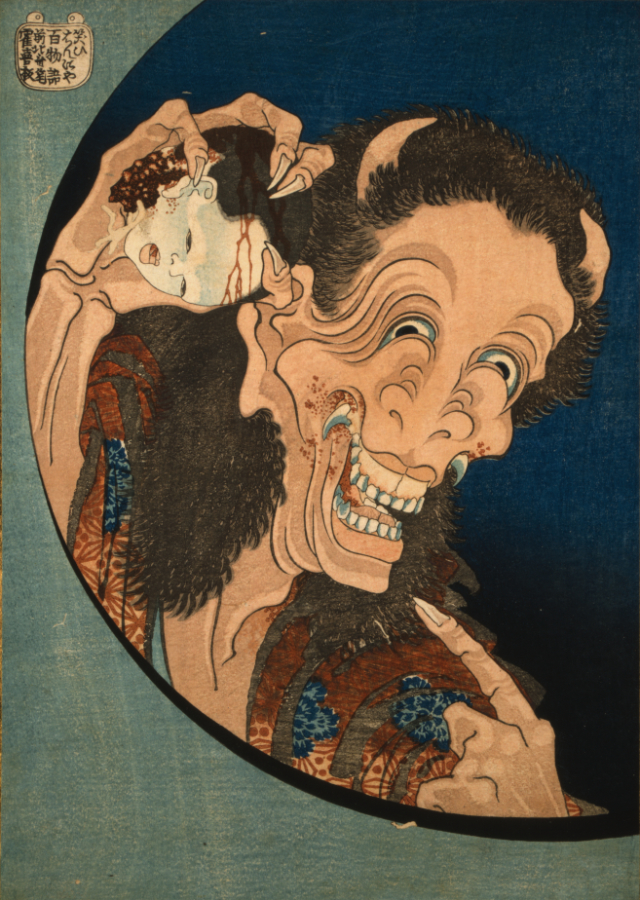Mostly said to resemble women, yamauba may be depicted as predatory monsters or benevolent beings. Depending on the text and translator, the yamauba often appears as a monstrous crone, “her unkempt hair long and golden white … her kimono filthy and tattered”, with cannibalistic tendencies. The yamauba is said to have a mouth at the top of her head, hidden under her hair. In one story, it is revealed that her only weakness is a certain flower containing her soul. The people attacked by yamauba in folklore are typically travelers and merchants (such as ox drivers, horse drivers, coopers, and notions keepers) who often travel along mountain paths and encounter people in the mountains, so they are also thought to be the ones who had spread such tales. In one tale, a mother traveling to her village is forced to give birth in a mountain hut assisted by a seemingly kind old woman, only to discover too late that the stranger is a yamauba, with plans to eat her helpless son Kintarō. In another story, the yōkai raises the orphan hero Kintarō, who goes on to become the famous warrior Sakata no Kintoki. Yamauba have been portrayed in two different ways. There were tales where men stocking oxen with fish for delivery encountered yamauba at capes and were chased by them, such as the Ushikata Yamauba and the Kuwazu Jobo, as well as a tale where someone who was chased by a yamauba would climb a chain appearing from the skies in order to flee, and when the yamauba tried to make chase by climbing the chain too, she fell to her death into a field of buckwheat, called the “Tendo-san no Kin no Kusari”. In these tales, the yamauba is a fearsome monster trying to eat humans. On the other hand, there are tales such as the Nukafuku Komefuku (also called “Nukafuku Kurifuku”), where two sisters out gathering fruit meet a yamauba who gives treasure to the kind older sister (who was tormented by her stepmother) and curses the ill-mannered younger sister with misfortune. There is also the “Ubakawa” tale, where a yamauba gives a human good fortune.
| Alias Yamauba (山姥, 山うば, or 山女郎) |
| Real Names/Alt Names The Laughing Demon; Alt: The Laughing Hannya (Warai-hannya), The Laughing Demoness or Ogress |
| Characteristics Yōkai, Scientific Revolution, Japanese |
| Creators/Key Contributors ○ |
| First Appearance Japanese folklore |
| First Publisher ○ |
| Appearance List Bakemono no e (化物之繪, “Illustrations of Supernatural Creatures”, Edo Period), Gazu Hyakki Yagyō (画図百鬼夜行, “The Illustrated Night Parade of a Hundred Demons” or The Illustrated Demon Horde’s Night Parade, 1776) Vol. 1 “Yin” |
| Sample Read Bakemono no e (Edo Period) [Internet Archive] |
| Description Mostly said to resemble women, yamauba may be depicted as predatory monsters or benevolent beings. Depending on the text and translator, the yamauba often appears as a monstrous crone, “her unkempt hair long and golden white … her kimono filthy and tattered”, with cannibalistic tendencies. The yamauba is said to have a mouth at the top of her head, hidden under her hair. In one story, it is revealed that her only weakness is a certain flower containing her soul. The people attacked by yamauba in folklore are typically travelers and merchants (such as ox drivers, horse drivers, coopers, and notions keepers) who often travel along mountain paths and encounter people in the mountains, so they are also thought to be the ones who had spread such tales. In one tale, a mother traveling to her village is forced to give birth in a mountain hut assisted by a seemingly kind old woman, only to discover too late that the stranger is a yamauba, with plans to eat her helpless son Kintarō. In another story, the yōkai raises the orphan hero Kintarō, who goes on to become the famous warrior Sakata no Kintoki. Yamauba have been portrayed in two different ways. There were tales where men stocking oxen with fish for delivery encountered yamauba at capes and were chased by them, such as the Ushikata Yamauba and the Kuwazu Jobo, as well as a tale where someone who was chased by a yamauba would climb a chain appearing from the skies in order to flee, and when the yamauba tried to make chase by climbing the chain too, she fell to her death into a field of buckwheat, called the “Tendo-san no Kin no Kusari”. In these tales, the yamauba is a fearsome monster trying to eat humans. On the other hand, there are tales such as the Nukafuku Komefuku (also called “Nukafuku Kurifuku”), where two sisters out gathering fruit meet a yamauba who gives treasure to the kind older sister (who was tormented by her stepmother) and curses the ill-mannered younger sister with misfortune. There is also the “Ubakawa” tale, where a yamauba gives a human good fortune. |
| Source Yama-uba – Wikipedia |

